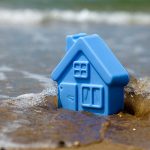Know your foundation and what repairs you need before insulating your basement
Did you know a poorly insulated basement can account for 20 percent of your home’s heat loss? Being familiar with your foundation can help you decide how to insulate your basement, keep the heat in, and save thousands of dollars in heating costs.
Where does the heat go?
A lot of heat is lost at the top of your foundation walls, where the sill plate rests. The sill is the transition between your home’s foundation and its framing.
In newer construction, a gasket—made of vinyl, rubber or polyethylene foam, is placed under the sill. This helps seal the gap between the sill and foundation. Older homes lack this gasket and lose more heat from this area.
For existing homes, you can caulk the sill from the inside with a “minimal expansion” flexible foam sealant, suitable for masonry and wood.
For an existing home, sealing the sill from the outside is often impractical, as you may have to remove siding, brick veneer or parging to get at the sill plate.
The joist rim space is where floor joists rest. Depending on your home’s construction, joists may rest on top of the sill plate, or may be partially or fully cast into the foundation wall. Caulk around the joists where they meet the sill before insulating this area.
Heat also escapes through your foundation walls and floor. It’s a common misconception that earth is a good insulator. Before insulating, know what type of foundation you have and what steps to take beforehand.
Types of foundations
Most homes in the Ottawa area have a full foundation basement, with foundation walls mostly underground (below grade). Some homes have a crawl space, with partial-depth foundation walls. In warmer places, some homes are built on a concrete slab at ground level (slab-on-grade), where there’s no basement at all.
Concrete foundations
The most common full foundation basement is poured concrete. Concrete block foundations are also common, but less popular than poured.
Newer concrete foundations usually have parging on the exposed outside area above grade, damp-proofing or waterproofing below grade, and some kind of drainage (weeping) tile at the footings. If your house is more than 20 years old, any of these elements may need some repair.
Before you insulate a concrete foundation, make sure there are no serious structural or water problems. To understand signs and causes of foundation problems, consult Affordable Concrete Service’s tips on recognizing foundation damage.
Concrete foundations can be insulated from the outside or inside. Outside is more feasible when a house is being built. For an existing home, it may be impractical to dig up around its perimeter, or it may not make financial sense.
Older brick or stone foundations
Very old foundations built with stone, brick or rubble lack damp-proofing and can have higher moisture levels. They contain a lot of mortar, which absorbs additional soil moisture. You should consult a foundation repair specialist and insulation specialist with expertise in stone foundations before insulating.
Assess your basement for leaks or dampness
Major water leaks must be fixed before insulating your basement. Especially if you’re finishing it. Water and moisture can rot your new interior walls. You may have to excavate, damp-proof or waterproof, and add a drain system. In these cases, it may make sense to insulate from the outside.
Minor water leaks can sometimes be addressed by sloping the grade away from your foundation, directing downspouts farther away from your house, and patching from the inside.
Should I insulate my basement from the outside or inside?
Insulating from the outside is best, but it’s more expensive and often impractical for existing homes.
Insulating from the inside
Insulating from the inside can be effective. The materials you use will depend on whether you’ll finish your basement, and if you have moisture issues. You’ll also have to account for vapour barriers.
Adding insulation to the inside makes your foundation walls colder. Humid air that contacts cold foundation walls will condense. This is why you need an effective vapour barrier to stop the humid air from contacting colder foundation walls.
To successfully insulate basement walls, you have to stop moisture movement and prevent mould growth.
Before insulating from the inside, make sure you:
- Check foundation walls and make any structural or water leakage repairs.
- Seal air leakage areas, such as the sill and any electrical, plumbing or HVAC penetrations.
- Consider insulation requirements (RSI / R-Value).
- Account for plumbing or wiring upgrades.
- Account for finishing details.
The type of insulation material you use dictates what kind of vapour barrier you need. Spray foam insulation acts as its own vapour barrier. Rigid foam board insulation, if sealed with a proper adhesive to the foundation, creates a vapour barrier similar to spray foam.
If you choose batt insulation, such as mineral wool or fibreglass, apply a vapour barrier over the studs and insulation. In dry basements, polyethylene sheeting is suitable.
If dampness is a concern, use a nylon vapour retarder or “smart” barrier, which changes its vapour permeability based on conditions inside the wall cavity. If there’s too much humidity inside the wall, the “smart” barrier will allow the wall to dry to the inside, unlike polyethylene.
Insulating from the outside
When you insulate from the outside, you eliminate the stresses that come with the freeze-thaw cycle. The entire foundation is insulated which can even out temperature changes within your home. It’s also easier to spot and fix structural or moisture problems from the outside.
If you’re digging up outside your home to fix your foundation, or if you’re building a new home, you may wish to consider the exterior approach.
Before insulating basement walls from the outside:
- Choose a reputable foundation repair expert and an insulation specialist.
- Obtain appropriate permits.
- Locate gas, electrical and water services.
- Ensure adequate room for equipment.
Outside insulation materials include rigid mineral wool board, polystyrene foam board and polyurethane foam board. Polystyrene is most common for below-grade exterior insulation.
Exterior insulation requires digging, waterproofing, insulating, drainage, backfill, a protective coat and flashing. It’s a big undertaking that may take several weeks—even longer if you need to repair cracks, waterproofing and drainage tiles.
Be comfortable with your contractor
Insulating your basement can help you save thousands of dollars in heating costs. Depending on how long you plan to own your home, it can be a very worthwhile investment.
Knowing what kind of foundation you have and what repairs you may need before insulating your basement is extremely important.
If you’re handy, you may wish to do some of the work yourself. For many parts of the job, especially exterior work, you’ll likely need a contractor.
Make sure you’re comfortable with who you pick and and don’t be afraid to ask questions. A good contractor will fully explain the process, give you different options, and tell you the pros and cons of each approach. Contact us today and let us provide you with a free quote on your next project.








